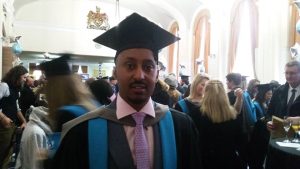By Muhammad Suldaan Said
On one brilliantly sunny afternoon in 1992 under a magnificent acacia tortilis1 tree surrounded by wild shrubs, hook-thorn acacias2 and the glory of the forest, came the dreadful news that a close relative of mine has mercilessly slain a man from another formidable local clan. As that frightfully spine-chilling news gradually kept streaming in, the dire consequence of this particularly worrisome murder became apparent to everyone familiar with the antagonistic history of the sub-clans concerned.

The forest’s sweet fragrance of which can only be described as the lush Garden of Eden, accompanied by meticulous chorus of yellow-billed hornbill3 chirping, was suddenly replaced by a mixture of fear and primordial tribal survival mode. Under that cloud of perceived uncertainty, my dad being the traditional leader of the clan, convened an emergency communal meeting to discuss this potentially perilous situation.
Next morning at the crack of dawn, a hastily organised consultation meeting began just outside of Qararo village, which lies approximately 72km southwest of Buhotle district deep into the Somali inhabited territory in Ethiopia.Sadly tribalism being the curse of Somalis, and perhaps mindful of the seriousness of the murder, hundreds of heavily armed clansmen gathered at the meeting to hear what the elders had to say about the matter and how best to tackle this nerve-racking quandary.
After a quick recitation of Qur’anic verses, a middle-aged stocky-man famously known for his legendary oratory ability within my community, addressed the tribal meeting with impassioned yet defiant speech. He passionately argued against any leniency towards the other part as they too, he said, have killed fellow clansmen in the past with impunity and that there has always been a tempestuous relationship between the two families concerned. Harsh topographical challenges of the terrain coupled with their nomadic culture have over-generations made people hard-hearted and highly combative.
As the polarising exchange of views heated up, a majestically colourful hoopoe4 elegantly perched on a nearby Ziziphus Mauritiana5 branch wheezing as if it’s singing the famous Ismail Mire’s poem “ragoow kibirka waa lagu kufaa kaa hala ogaado.” Not far from that picturesque scene of heavily forested nature, remains of half-burnt skeleton of dead trees left out by recent fire diminish what is otherwise a paradise of green jungle rich with overgrown vegetation and dew-laden grass.
The victim’s mighty tribe known for their ferocious men warriors, immediately mobilised themselves and gave us a week to hand the perpetrator in or face the full wrath and rage of their culturally militarised tribesmen. It is a hell on earth environment where nature lied down punishingly tough rules of survivability. The legend has it that even Satan the supreme spirit of evil, is frightened when he overhears their name alone. They are multitude in number compared to my much smaller clan, egomaniac in nature and immensely glorified in local literature as the Zulu of Hawd who could have even decimated the mighty Romans had they met.
With his unmatched leadership qualities, his excellent persuasion ability complemented by forward-thinking attitude and his realisation of the grim future ramifications, my dad took a drastic decision. Since the perpetrator of this heinous crime belonged to us and disappeared into the mist, to prevent and de-escalate any further hostility between these brotherly clans, my dad determinedly instructed that a blood-compensation of 120 hand-picked camels must be immediately paid to the victim’s clan. And as a sign of goodwill and reconciliatory gesture, he further advised that two girls must also be married out to the wronged clan for the peace and social harmony to prevail (while undoubtedly radical feminists will rip me apart by saying this nevertheless it’s widely believed, that inter-tribal marriages can help harmonise warring communities and act as both peacebuilding but also conflict preventative measure).
I was a kid at the time of the tragedy, nonetheless I still vividly remember how my dad’s shrewd intervention averted what could’ve been a catastrophic tribal war with the magnitude of seismic scale and because of that bold peace making decision he took, today both communities live side by side in peace and mutual respect. My dad has always been a source of great inspiration to me for his imaginative ability to throw light on where a blanket of darkness engulfed, where communal divisiveness became the norm of the day, and where centuries of interwoven social fabric is weakened by lack of governmental presence. He is still tirelessly continuing to extinguish the flame of tribal animosity with love and has been promoting social amity.
It is almost impossible to apply conventional conflict mechanisms in tribal territories where rule of law is virtually non-existent and tribal chauvinism outperforms common interest. My dad resting under this imposing schinus molle6 tree in front of our home, would from time to time, summon my older brother and I to instil conflict resolution mechanisms into us. He therefore, because of his selfless community service, inspired me to be a social scientist in order to scientifically explore the inner-workings of social structures and human beings through time and space.
Muhammad Suldaan Said
Muhammad Suldaan read Sociology and History at Kingston University in London and he is currently studying his Master’s degree in Social Anthropology at School of Oriental and African Studies (SOAS) London, UK
He can be reached at Suldaanz@hotmail.com
————-
Notes:
1.Geedka Qudhaca
2.Geedka Cadaadda
3.Shimbirta Qudunquutada
4.Shimbirka Guuguulaha
5.Geedka Gobka
6.Geedka Miri-mirida

Leave a Reply